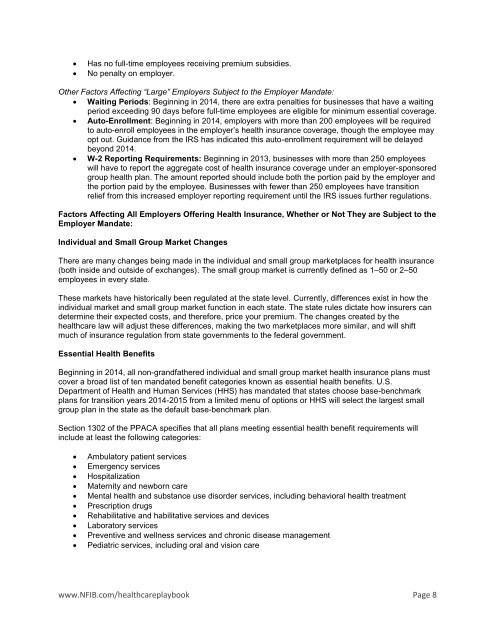ppaca-healthcare-law-guide-nfib
ppaca-healthcare-law-guide-nfib
ppaca-healthcare-law-guide-nfib
You also want an ePaper? Increase the reach of your titles
YUMPU automatically turns print PDFs into web optimized ePapers that Google loves.
� Has no full-time employees receiving premium subsidies.<br />
� No penalty on employer.<br />
Other Factors Affecting “Large” Employers Subject to the Employer Mandate:<br />
� Waiting Periods: Beginning in 2014, there are extra penalties for businesses that have a waiting<br />
period exceeding 90 days before full-time employees are eligible for minimum essential coverage.<br />
� Auto-Enrollment: Beginning in 2014, employers with more than 200 employees will be required<br />
to auto-enroll employees in the employer’s health insurance coverage, though the employee may<br />
opt out. Guidance from the IRS has indicated this auto-enrollment requirement will be delayed<br />
beyond 2014.<br />
� W-2 Reporting Requirements: Beginning in 2013, businesses with more than 250 employees<br />
will have to report the aggregate cost of health insurance coverage under an employer-sponsored<br />
group health plan. The amount reported should include both the portion paid by the employer and<br />
the portion paid by the employee. Businesses with fewer than 250 employees have transition<br />
relief from this increased employer reporting requirement until the IRS issues further regulations.<br />
Factors Affecting All Employers Offering Health Insurance, Whether or Not They are Subject to the<br />
Employer Mandate:<br />
Individual and Small Group Market Changes<br />
There are many changes being made in the individual and small group marketplaces for health insurance<br />
(both inside and outside of exchanges). The small group market is currently defined as 1–50 or 2–50<br />
employees in every state.<br />
These markets have historically been regulated at the state level. Currently, differences exist in how the<br />
individual market and small group market function in each state. The state rules dictate how insurers can<br />
determine their expected costs, and therefore, price your premium. The changes created by the<br />
<strong>healthcare</strong> <strong>law</strong> will adjust these differences, making the two marketplaces more similar, and will shift<br />
much of insurance regulation from state governments to the federal government.<br />
Essential Health Benefits<br />
Beginning in 2014, all non-grandfathered individual and small group market health insurance plans must<br />
cover a broad list of ten mandated benefit categories known as essential health benefits. U.S.<br />
Department of Health and Human Services (HHS) has mandated that states choose base-benchmark<br />
plans for transition years 2014-2015 from a limited menu of options or HHS will select the largest small<br />
group plan in the state as the default base-benchmark plan.<br />
Section 1302 of the PPACA specifies that all plans meeting essential health benefit requirements will<br />
include at least the following categories:<br />
� Ambulatory patient services<br />
� Emergency services<br />
� Hospitalization<br />
� Maternity and newborn care<br />
� Mental health and substance use disorder services, including behavioral health treatment<br />
� Prescription drugs<br />
� Rehabilitative and habilitative services and devices<br />
� Laboratory services<br />
� Preventive and wellness services and chronic disease management<br />
� Pediatric services, including oral and vision care<br />
www.NFIB.com/<strong>healthcare</strong>playbook Page 8


